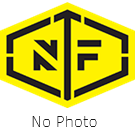edit these instructions at Instructions:Miller Millermatic 212 Autoset MIG Welder
Safety
CAUTION: Equipment Damage. Do not open or service the welding machine or change gas cylinders without staff permission.
Hazards
The following is an overview. Please check the SWP for more details.
Hazards include hot workpiece, sparks, dripping molten metal, fumes, risk of electrical shock, explosion of gas, moving parts, radiation burns on exposed skin, blinding.
DO NOT WELD galvanized steel, leaded plate, or materials containing cadmium.
PPE and Clothing
PPE and clothing choices are extremely important when welding.
PPE
Clothing
- Nonflammable, non-synthetic clothing
- Long pants and sleeves - no exposed cuffs or pockets that could catch sparks
- Safety boots (ideally high tops to prevent sparks from entering, OHM rating)
- Remove everything from pockets before welding (phone, keys, lighters)
Operations
Pre-use checks
- Check workpiece for contaminants (oil, paint)
- Check workspace for hazards - everything (including the operator) should be clean and dry
- Setup weld curtains and warn anyone nearby that you will be welding
- Check leads and power cord for damage before beginning, and inspect nozzle for cleanliness. Use the welding pliers to clean the nozzle as needed.
- It's possible to damage the cord and plug when pulling the welder away from the wall.
- Check PPE is in good condition (especially welding helmet shade)
Startup
- Set up and turn on FRED Welding fume extractor
- Attach ground clamp securely to the welding bench or to an exposed metal part of your workpiece.
- Open the main gas valve slightly and ensure there is no hissing sound or leaking. Fully open the valve.
- Turn the machine on and, with voltage and wire speed at zero, pull the trigger and adjust the gas regulator valve to allow 20-35 CFH.
- Adjust voltage and wire feed speed to settings found on chart on the machine.
- Check amount of wire stickout before beginning a weld. Pull the trigger to feed out extra wire, tap it onto the workbench to discharge any extra charge, and trim the wire with welding pliers.
Procedure
Work Angle-angle of the nozzle relating to the joint and piece. Should point directly into the joint.
Travel Angle-angle of the nozzle relating to the direction of travel. Can be 10-15* in a push or drag angle.
Using both hands on the gun, position yourself comfortably and sturdily, with your supporting arm or hand resting on something solid. Adjust your hands so the nozzle is pointing into where you want to weld, and your travel angle and work angle are appropriate. Rehearse your weld and make sure you don't get caught on anything, that your angle doesn't change towards the end of the weld, and that you can reach where you need to weld.
Pull the trigger and begin moving. Be aware of the puddle just behind where the brightest arc is and how much of a bead is forming, and adjust your speed as needed. Slower will cause a larger weld and retain heat and penetrate deeper and may cause holes. Faster may not fill up enough and cause undercut, or just sit on the top and not fuse.
If you find there is porosity in the weld, confirm or adjust your gas settings, and make sure the workpiece is clean of all grease, dirt, or paint.
Shutdown and Housekeeping
- Dispose of any scrap or unused pieces in the metal recycling (metal barrel)
- Set aside any hot metal on the bench to cool while you clean up the area. Be aware that if you leave a workpiece to cool down before moving or disposal, other members may not know that it is hot - please stay nearby or put up a sign.
- Turn off MAIN gas cylinder handwheel valve first.
- Bleed regulator with wire feed speed and voltage at lowest settings, ensure hissing has stopped, and tap the wire on the workbench to discharge any remaining charge.
- Turn off welder, remove ground clamp and wind the leads neatly onto the welder.
- Stow the welder under the workbench neatly.
- FIRE WATCH: stay in the area of work for 30 minutes for safety - use this time to clean up/reset the space.
- Put away all hand tools, grinders and materials in their places.
